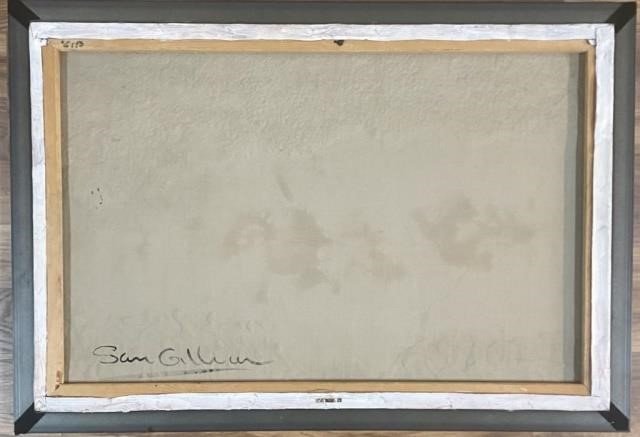Sam Gilliam Original Signed Acrylic on Canvas Framed Painting 27" H x 39" W
In the style of “Sam Gilliam” an African-American color field painter and lyrical abstractionist artist. This canvas is signed on both sides “Sam Gilliam”
Measurements 27" H x 39" W framed
Condition- Good
In the style of “Sam Gilliam” an African-American color field painter and lyrical abstractionist artist. This canvas is signed on both sides “Sam Gilliam”
Measurements 27" H x 39" W framed
Condition- Good
In the style of “Sam Gilliam” an African-American color field painter and lyrical abstractionist artist. This canvas is signed on both sides “Sam Gilliam”
Measurements 27" H x 39" W framed
Condition- Good
Sam Gilliam is associated with the Washington Color School, a group of Washington, D.C. area artists that developed a form of abstract art from color field painting in the 1950s and 1960s.In 1971, he boycotted an event at the Whitney Museum, in New York, in support of and in solidarity with the Black Emergency Cultural Coalition as a protest against the museum for failing to consult with black art experts in selecting art for the show.
In 1972, Gilliam represented the US at the Venice Biennale, the first African-American artist to do so.In 2017, he exhibited at the Venice Biennale once again, in the Giardini's central pavilion. Gilliam was influenced by German Expressionists such as Emil Nolde, Paul Klee, and the American Bay Area Figurative School artist Nathan Oliveira. Early influences included Morris Louis and Kenneth Noland. He says that he found many clues about how to go about his work from Tatlin, Frank Stella, Hans Hofmann, Georges Braque, Pablo Picasso, and Paul Cézanne. In 1963, Thomas Downing, an artist who identified himself with the Washington Color School, introduced Gilliam to this new school of thought. Around 1965, Gilliam became the first painter to introduce the idea of the unsupported canvas. He was inspired to do this by observing laundry hanging outside his Washington studio.[6] His drape paintings were suspended from ceilings or arranged on walls or floors, representing a sculptural third dimension in painting. Gilliam says that his paintings are based on the fact that the framework of the painting is in real space. He is attracted to its power and the way it functions. Gilliam's draped canvases change in each environment where they are arranged and frequently he embellishes the works with metal, rocks, and wooden beams.[20] He received countless public and private commissions for these draped canvases which earned him the title of the "father of the draped canvas." On of his last, and largest, works within this series was titled Seahorses, and was made in 1975 for the Philadelphia Museum of Art. The work consisted of six parts and was made of hundreds of feet of canvas./Private collection, no documentation






